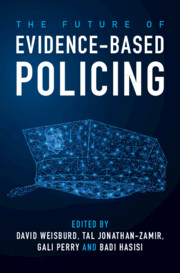Book contents
- The Future of Evidence-Based Policing
- The Future of Evidence-Based Policing
- Copyright page
- Contents
- Figures
- Tables
- Contributors
- Editors
- 1 The Future of Evidence-Based Policing
- Part I Taking Stock of Evidence-Based Policing
- 2 Three Tiers for Evidence-Based Policing
- 3 Re-inventing Policing
- 4 A Way Ahead
- Part II The Evidence for Evidence-Based Policing
- Part III Innovations in Tools of Evaluation and Assessment
- Part IV Challenges to the Implementation of Evidence-Based Policing
- Part V The Practitioner’s Perspective
- 17 Conclusions
- Index
- References
2 - Three Tiers for Evidence-Based Policing
Targeting “Minimalist” Policing with a Risk-Adjusted Disparity Index
from Part I - Taking Stock of Evidence-Based Policing
Published online by Cambridge University Press: 01 June 2023
- The Future of Evidence-Based Policing
- The Future of Evidence-Based Policing
- Copyright page
- Contents
- Figures
- Tables
- Contributors
- Editors
- 1 The Future of Evidence-Based Policing
- Part I Taking Stock of Evidence-Based Policing
- 2 Three Tiers for Evidence-Based Policing
- 3 Re-inventing Policing
- 4 A Way Ahead
- Part II The Evidence for Evidence-Based Policing
- Part III Innovations in Tools of Evaluation and Assessment
- Part IV Challenges to the Implementation of Evidence-Based Policing
- Part V The Practitioner’s Perspective
- 17 Conclusions
- Index
- References
Summary
As the COVID19 Pandemic disrupted the world in 2020, it produced a new strategy of using geographic “Tiers” in public health, especially in the UK: the idea that the intrusiveness of prevention policies should be proportionate to the geographically varying risk of harm from the virus, with greater intrusiveness targeted selectively on only the highest-risk locations in order to cause minimal disruption. A Tiered policing system to prevent serious violence could apply the same principles, especially with proactive strategies such as stop and search. While such strategies can be effective when targeted on very violent hot spots, they can also minimize collateral damage if they are largely restricted to hot spots. This chapter shows how police legitimacy in democracies could be enhanced by confining most highly-intrusive policing, such as stop and search, to “highest-tier” areas for serious violent victimizations, possibly limited to 5% of all places in a city. Equality of intrusive protection across racial groups within the most violent Tier could be tracked and regulated by a Risk-Adjusted Disparity (RAD) Index. In lower tier areas, reducing proactive policing could reduce friction between police and community, and provide the greatest benefit yet offered by evidence-based policing.
Keywords
- Type
- Chapter
- Information
- The Future of Evidence-Based Policing , pp. 19 - 43Publisher: Cambridge University PressPrint publication year: 2023
References
- 6
- Cited by

